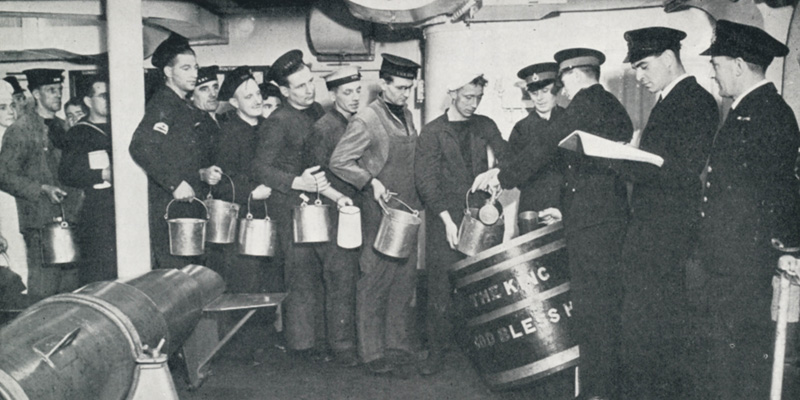By Merriam-Webster’s definition, grog can be either “any alcoholic drink (such as beer),” or “an alcoholic drink containing liquor (such as rum) mixed with water.” It can also be a liquor “cut with water and now often served hot with lemon juice and sugar.” There’s no misconception about who grog is for either, since the example sentence is “sailors clamoring for more grog.”
Maybe Merriam-Webster is capitalizing on a general “Pirates of the Caribbean“-level of understanding, but the simple, dirty, and arguably distasteful definitions and example of grog belie 300 years of Royal Navy history.
The story of grog begins with the story of colonialism, British expansion and rum. William Penn (the father of the William Penn who passed on his name to Pennsylvania) landed in what is now known as Jamaica in the 1600s. As Brits were wont to do in those days, he stole the land from the natives and claimed it for the Royal Crown.
Penn and his men couldn’t get all the way across the pond without the help of beer and fortified wine, however. In short, water just wasn’t fit to drink, and alcohol was. The only problem was that wine and beer weren’t readily available in the New World. Enter sugar and human kind’s natural inclination to turn anything fermentable into drinkable alcohol.
By the 1700s, standard issues of sugarcane’s delicious fermented liquid (rum) were common on every British Royal Navy ship. Which, even though it usually worked out for Captain Jack Sparrow, is not the best way to keep a clear-eyed crew.
A pioneering English admiral by the name of Edward Vernon saw the need to keep his men from drunkenly steering their ship through troubled waters (without having to drink water, of course). The admiral, who went by the nickname “Old Grog” because of his heavy grogram cloak made out of a mixture of silk, mohair and wool, came up with a solution in 1740.
Per the National Museum of the Royal New Zealand Navy:
“The daily allowance of half a pint a man is to be mixed with a quart of water, to be mixed in one Scuttled Butt kept for that purpose, and to be done upon Deck, and in the presence of the Lieutenant of the Watch, who is to see that the men are not defrauded of their allowance of Rum; it is to be served in two servings, one in the morning and the other in the afternoon. The men that are good Husbands may from the savings of their Salt Provisions and Bread, purchase Sugar and Limes to make the water more palatable to them.” — Admiral Vernon’s Official Order on August 21, 1740 on Her Majesty’s Ship Burford in the Port Royal Harbor.
Old-timey Brits really loved their commas and random capitalizations.
The sailors, to put it lightly, were not pleased. They needed to throw liquor down their throats because it made it a lot more tolerable to deal with awful living conditions and endless scrubbing of the poop deck. So, in their spite, they started to call the drink “grog,” after Old Grog himself.
Little did the sailors know at the time, however, that grog would eventually save the lives of thousands of sailors — at least the ones who gave up their salt and bread for sugar and lime.
The leading cause of naval death between 1500 and 1800, Jason Mayberry writes in a Harvard paper, was scurvy. It killed more sailors “than all other diseases, disasters, and battles combined.” In the Seven Years’ War from 1756 to 1763, for example, 133,708 of the 184,899 sailors died from disease, mostly scurvy. By comparison, only 1,512 sailors died in battle.
The lime helped prevent scurvy, which is caused by a lack of vitamin C. Sailors didn’t know that at the time, though; they were just mixing up a course, unmeasured drink that coincidentally has the same ingredients as a daiquiri. So much for the hard life.
Grog, despite its rocky start, quickly became the Royal Navy’s most beloved drink. The servings served from the scuttlebutt (a cask) were known as a tot. Basically, most of Western history was shaped by sailors loaded with tots.

Time moved on, but the grog remained constant. The Royal Navy guzzled grog through the Revolutionary War, World War I, and World War II.
Finally, the British Parliament declared enough was enough. On July 30, 1970, which was dubbed “Black Tot Day,” the last grog ration was given to the Royal Navy’s sailors.
“While recognizing the historical significance and service traditions associated with the tot, the rationale for the spirit issue as a compensation for poor food and living conditions no longer applied in today’s navy,” Chief of Naval Staff Somerford Teagle wrote in 1990. “And the daily issue of strong spirit is imply not appropriate in a high technology service which places increasing emphasis on individual responsibility.”
Today, grog can mean just about anything a person wants it to. Most often, the word will be used by someone who still hasn’t gotten over the dreadlocked version of Johnny Depp. Which is fine if that’s what you’re into, just don’t forget grog’s royal history.

